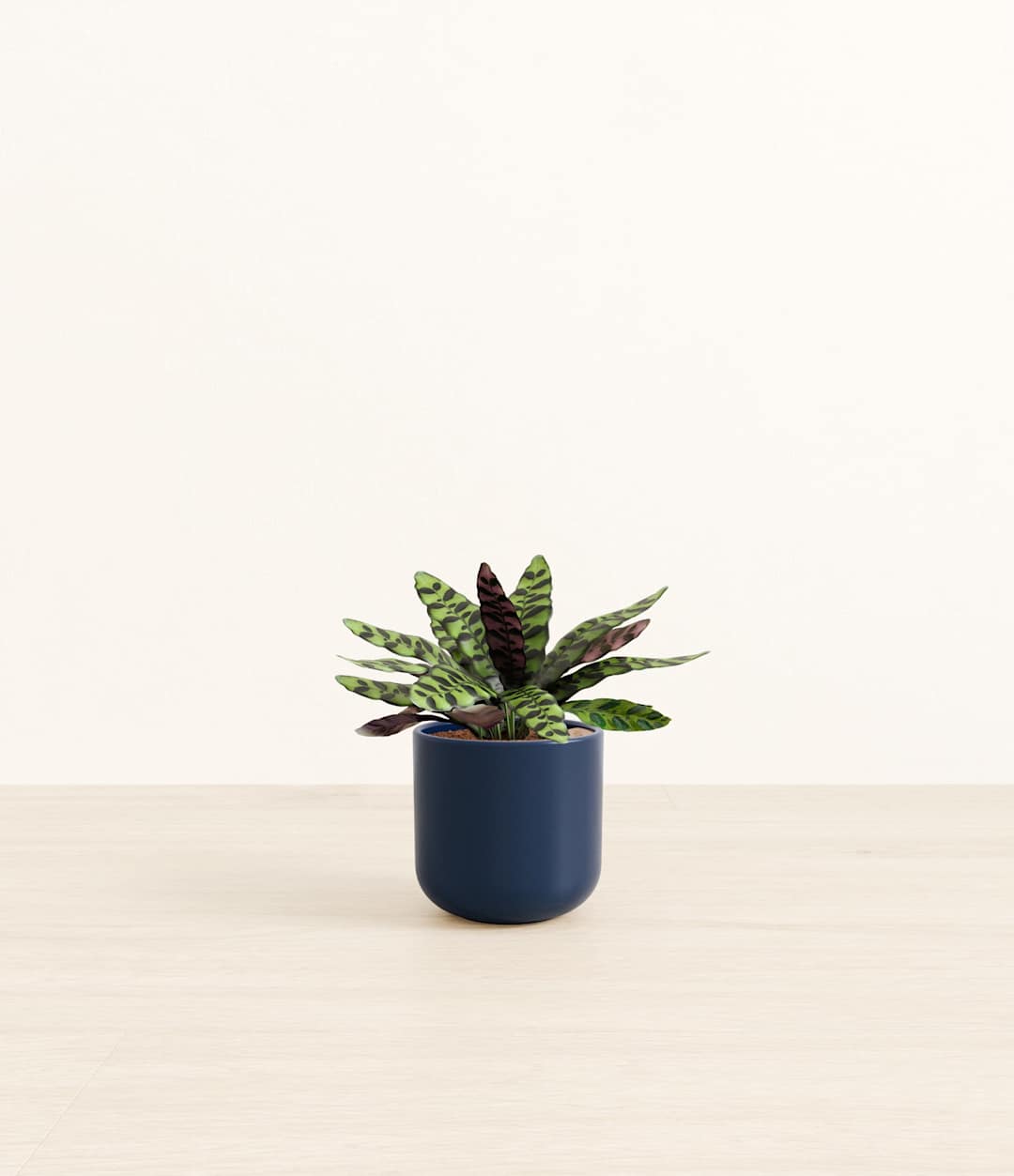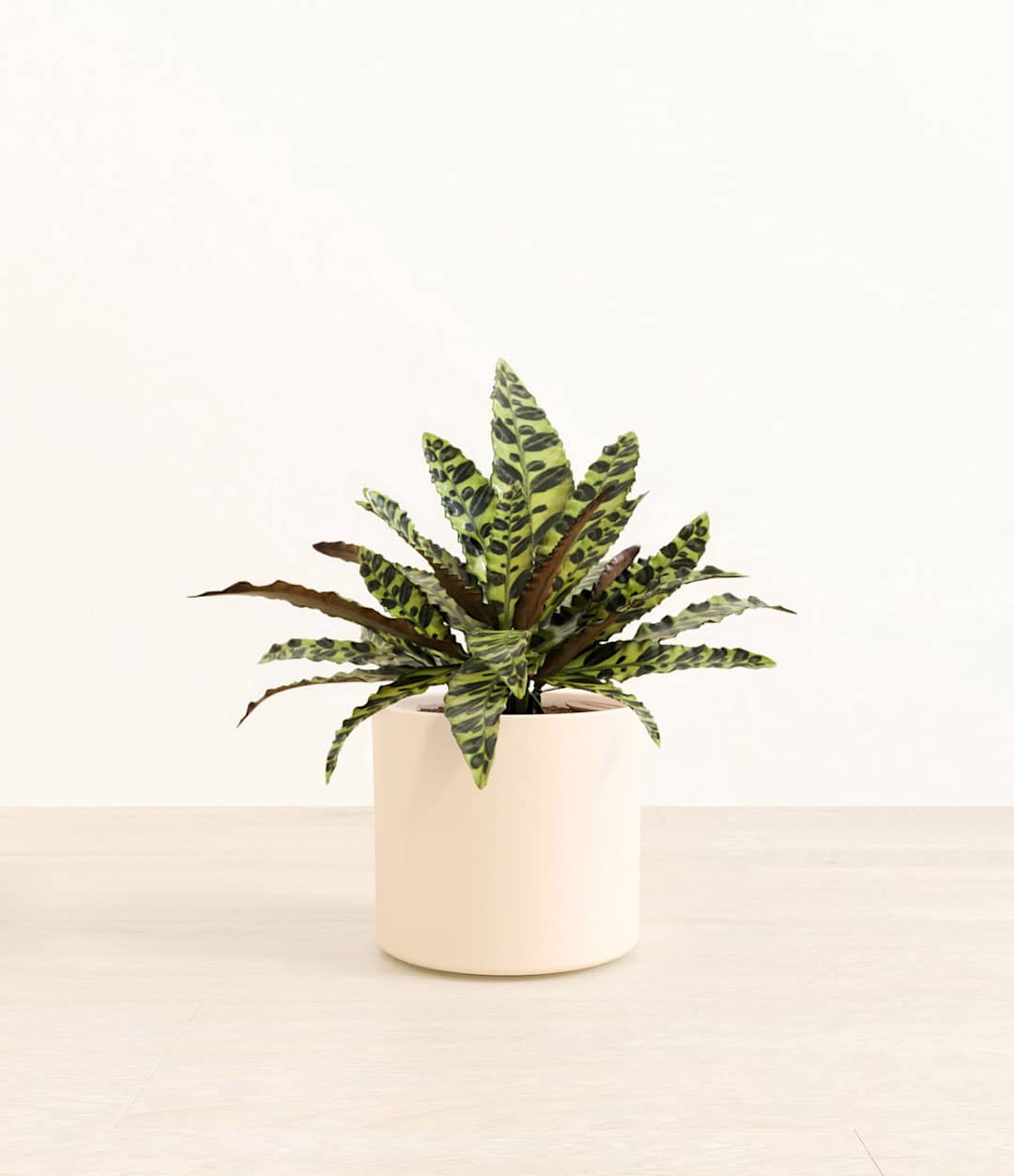How to Care for a Calathea Lancifolia
Shop this plantAbout the Calathea Lancifolia
Native to the Amazonian jungles of South America, the Calathea Lancifolia features an eccentric reptilian pattern on its leaves, with a purple underside and lush green brushstrokes on top. It belongs to the Marantaceae family, often referred to as 'Prayer Plants.' Like humans (unlike most plants), these plants have a wake-and-sleep cycle according to their circadian rhythm. This means the leaves move upwards during the night and downwards during the day in search of sunlight.
Other common names
- Rattlesnake Calathea
- Rattlesnake Calathea
- Rattlesnake Calathea
- Rattlesnake Calathea
- Rattlesnake Calathea
How Often Should I Water My Calathea Lancifolia?
Self-watering pots are the best option for the Calathea Lancifolia. They allow the plant to absorb just the right amount of water without the risk of overwatering or underwatering. With easyplant’s self-watering system, caring for your Calathea Lancifolia is effortless. Simply check the easyplant reservoir once a month and top it up when it’s empty!
Calathea Lancifolia Light Needs
The Calathea Lancifolia thrives in bright, indirect light, where sunlight is diffused. It can also adapt to spaces with bright, direct light, where sunlight streams directly through the window. Avoid placing it in low-light spaces or areas without natural sunlight to maintain its vibrant colours.
Being native to tropical forests, it flourishes in medium, indirect light. A small amount of direct sunlight in the morning is acceptable, but midday or afternoon sunlight should be avoided. An east-facing window is ideal, though south- or west-facing windows work too, provided there are curtains or the plant is placed a few feet away from direct sunlight.
Calathea Lancifolia Care
Once you’ve found a permanent spot for your Calathea Lancifolia, avoid moving the pot too much to help it acclimatise. To support even growth, dust the leaves occasionally and rotate the pot by a quarter turn once a month. You can also prune old leaves to encourage new growth.
How Big Do Calathea Lancifolias Grow?
Calathea Lancifolias grow slowly and steadily, reaching a height of around 60cm. Once mature, they continue to grow new leaves, replacing older ones. During growth spurts, they may shed one or two leaves from the bottom. After a year or two, they will have reached their full height of 60 cm. From then on, they will become bushier but won’t grow taller. With the right care, these plants can produce several new leaves each month from spring to summer! Bright, indirect light, high humidity, and damp but not soggy soil will help the Calathea Lancifolia grow healthily. Be aware that this plant may slow down during the winter when it’s dormant.
Temperature & Humidity
Native to tropical climates, Calathea Lancifolias thrive in warm conditions, preferably between 18°C and 30°C. To prevent damage from the cold, maintain a temperature of at least 15°C. For optimal growth, humidity should be 50% or higher – similar to their natural rainforest habitat.
Are Calathea Lancifolias Toxic to Pets & Children?
Calathea Lancifolias are non-toxic and safe for both humans and animals. They’re pet-friendly, making them a great addition to homes with children or pets. However, to prevent your furry friends from nibbling on the leaves, place your plant somewhere out of reach. While excessive consumption might cause a mild stomach upset, it’s not dangerous or life-threatening.
Troubleshooting Common Problems with Calathea Lancifolia
If you notice the leaves curling, try moving the plant to a less brightly lit spot. If the lower leaves turn yellow (which could also be a sign of natural ageing), it could indicate overwatering. Brown leaf tips are typically caused by dry air or inadequate humidity – increase the humidity for better results. Cold temperatures and overwatering can cause limp stems, which can be harmful or even fatal if not addressed quickly.
Frequently Asked Questions about Rattlesnake Calathea Plant
- Is Calathea Lancifolia poisonous?
Calathea Lancifolia is non-toxic and safe for humans and animals alike. If the plant is ingested in large quantities, it may lead to an upset stomach or very mild irritation, but it will not cause any serious complications. It is important to keep the plant out of reach of children and pets, just in case.
- Where do you place a Calathea Lancifolia?
Calathea Lancifolias should be placed in a location away from direct sunlight, preferably one that gets indirect light. You'll want to avoid very cold temperatures and hot drafts, as the plant can easily become distressed in such conditions. East-facing windows are ideal for this plant; if you keep it indoors, rotate the pot monthly to allow even growing.
- Should you mist Calathea Lancifolia?
No, misting Calathea Lancifolia is not recommended, as it can lead to fungal issues and attract pests. Instead, consider alternative methods to provide the necessary humidity. Start by placing your plant in a room with naturally high humidity levels, such as a kitchen or a bathroom. Additionally, grouping your plant with other plants can create a more humid microenvironment. Another effective approach is to use a humidifier or place the plant on top of a pebble tray with water to maintain the desired humidity.
- How do you take care of a Calathea Lancifolia?
Taking care of a Calathea Lancifolia is easy. Keep its soil evenly moist, avoid midday or afternoon direct sunlight, and maintain warm temperatures and high humidity levels. Additionally, occasionally dust the leaves and rotate the pot monthly for optimal growth. With an easyplant self-watering pot, you can be sure to provide your plant with sufficient water without worrying about watering frequency.





